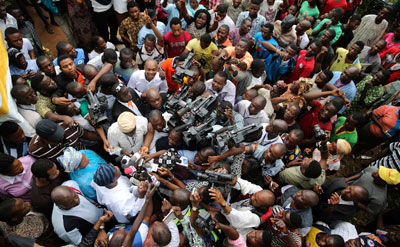Whether the planned nationwide protest on August 1 eventually holds or not, journalists still have the responsibility of bringing fresh information to the people. The nature of protest being a highly volatile situation makes the need for the safety of journalists of paramount concern.
So we asked journalists in our recent social media posts how they cover protests and we got responses from reputable journalists in Nigeria like the Editor-In-Chief and Director of News, TVC, Stella Din-Jacob and News Manager Nigeria Info FM, Wazobia and Cool FM Porthacourt, Chioma Ezenwafor. You can read their full responses and join the conversation here
We gathered this feedback and digested it with tips and resources from reputable international journalism bodies.
A few things cut across the feedback and the information gathered for journalists to take note of. They are:
Safety first, Story Second
As Stella Din Jacob said, “Protests by their very nature can be volatile and unpredictable” so preparing physically and mentally to report safely in the worst-case scenario is very important.
The broadcaster and news manager advises journalists “Please note, no heroics! With your tripod and lens, you can capture even a violent rally from a distance which is what you need.”
The first tip before setting out is to understand all the sides of the protest. Research, ask questions, follow arguments and understand the moods. This is to help adequately gauge and prepare for the reactions to the protest.
While covering the protests it is important to get close enough to safely capture photographs or video of the proceeding. Getting close enough as a reporter or cameraman should factor in your safety and access to escape routes when things escalate.
It is also important for reporters to understand the terrain of the protest and constantly plan escape routes.
Wear personal protective equipment and carry backpacks or grab bags for securing your equipment and carrying first aid and necessary provisions.
Be careful, even with information and their sources.
There is a need for journalists to be careful on the field, with their movement and the information they deal with.
As Chioma Ezenwafo said ”It is important to understand the underlying issues that have led to such protests and demonstrations and even their actors before the D-day so you don’t get caught up in the ‘wrong crowd”
Journalists on protest grounds need to practice adequate situational awareness to spring into action as needed. Constantly scanning the crowds and movement, noting the trends of happenings and identifying the different significant actors present at the protest grounds. Nigeria especially has a significant history of protest hijacks and peaceful protests turning violent within a short time.
Another important thing to be careful about is the information gotten from protests. The integrity of every information received and its sources must be double-checked. Eye-witness accounts and protester views especially need to be subjected to high-standard journalistic checks before being used for news.
Online mis/disinformation is also common during protests. Different actors trying to shape online conversations and drive narratives use false, diluted, doctored information and deep fake media to pollute the integrity of online information. Journalist need to be ready to fact-check online information and promote factual and accurate narratives.
[READ ALSO: 5 Important Digital Safety and Security Tips for Journalists]
Appearance and attitude matter:
The appearance of journalists, especially at sensitive places like protest grounds is very consequential. Journalists, reporters, cameramen and all media personnel at protest grounds need to dress the part. Be in comfortable and convenient clothing and shoes and always carry your ID cards/ permits.
Knowing where and when to wear identifiable clothes as pressmen is also important. Sometimes drawing attention with heavy media equipment might not be the best strategy. The smaller and lighter your equipment the easier it can be to nimbly move in chaotic situations.
It is also important for journalists to have the best attitude at protest grounds, know how to blend in, connect with people, relate with authorities, de-escalate issues and cultivate credible sources and connections at protest grounds for exclusive and credible information.
Maintain connection with your newsroom and support bodies.
Journalists on the field, especially sensitive ones like protest grounds should never lose connection with their newsroom, editors/managers and all the support connections and bodies for easy information syncing and emergencies.
It is common to have journalists harassed, attacked or even arrested at demonstrations by state and non-state actors in Nigeria. It is important to have a constant connection with support systems.
There are established networks and national and international bodies supporting journalists in areas like this.
Quick tips include sharing your live location with selected persons, making a speed dial list of support systems, and belonging to or subscribing to a network or body of journalists for support.
[READ ALSO:Call for ethical, responsible journalism at LASUSTECH UCJ’s exco inauguration]
Understand news framing and media responsibility.
Reporting on-the-ground information and experience from protest ground needs to be done with utmost care. Journalists need to have a good understanding of journalistic information standards, news framing and the responsibility of the media to the societies.
The use of subjective adjectives, and high-toned and clickbait headlines should be limited and factual accounts only should be promoted.
Rumours should be dispelled, inciteful information should be avoided, and balanced coverage should be given to all parties involved journalists should also be careful not to be tools for agenda-pushing.
Journalists should cultivate credible sources that can give them exclusive news and accurate analysis of the trends of happenings during demonstrations.
If you are interested in getting more tips on covering protests and demonstrations you can access some resources from the Poynter Institute of Media Studies, Committee to Protect Journalists and Reporters Without Borders


